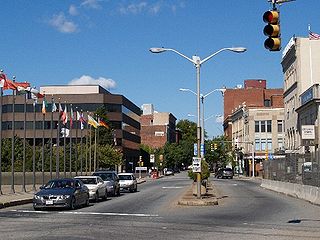
Fall River is a city in Bristol County, Massachusetts, United States. Fall River's population was 94,000 at the 2020 United States census, making it the tenth-largest city in the state. It abuts the Rhode Island state line with Tiverton, RI to its south.
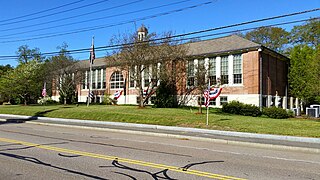
Raynham is a town in Bristol County, Massachusetts, United States, located approximately 32 miles (51 km) south of Boston and 22 miles (35 km) northeast of Providence, Rhode Island. The population was 15,082 at the 2020 census. It has one village, Raynham Center.
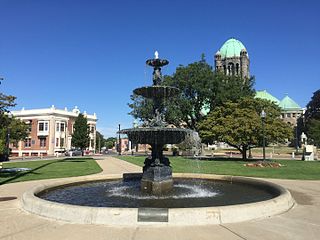
Taunton is a city and county seat of Bristol County, Massachusetts, United States. Taunton is situated on the Taunton River, which winds its way through the city on its way to Mount Hope Bay, 10 miles (16 km) to the south. At the 2020 census, the city had a population of 59,408. Shaunna O'Connell is the mayor of Taunton.

The Taunton River, historically also called the Taunton Great River, is a river in southeastern Massachusetts in the United States. It arises from the confluence of the Town River and Matfield River, in the town of Bridgewater. From there it meanders through the towns of Halifax, Middleborough and Raynham, through the city of Taunton for which it is named, the towns of Berkley, Dighton, Somerset, and the Assonet section of Freetown, to Fall River where it joins Mount Hope Bay, an arm of Narragansett Bay.

William Mason was a master mechanical engineer and builder of textile machinery and railroad steam locomotives. He founded Mason Machine Works of Taunton, Massachusetts. His company was a significant supplier of locomotives and rifles for the Union Army during the American Civil War. The company also later produced printing presses.

Samuel Leonard Crocker was a businessman and U.S. Representative from Taunton, Massachusetts. Crocker graduated from Brown University, Providence, Rhode Island, in 1822. Throughout his life, he engaged in various manufacturing and civic interests in his hometown of Taunton and throughout Massachusetts.

The Bridgewater Iron Works is a historic industrial site located on High Street in Bridgewater, Massachusetts, United States, along the banks of the Town River. Previously known as Lazell, Perkins and Company, by the mid-19th century, the Bridgewater Iron Manufacturing Company was one of the largest iron works in the United States, specializing in heavy castings and forgings. The property was later acquired by the Stanley Works, with the surrounding village still known to this day as Stanley.

For much of its history, the city of Fall River, Massachusetts has been defined by the rise and fall of its cotton textile industry. From its beginnings as a rural outpost of the Plymouth Colony, the city grew to become the largest textile producing center in the United States during the 19th century, with over one hundred mills in operation by 1920. Even with the demise of local textile productions during the 20th century, there remains a lasting legacy of its impact on the city.

The American Printing Company, located in Fall River, Massachusetts grew to become the largest producer of printed cotton cloth in the United States by the early 20th Century. The company grew as an offshoot of the Fall River Iron Works, established in 1821 by Colonel Richard Borden and Major Bradford Durfee. The American Print Works was established in 1835 by Holder Borden. It employed several thousand workers at its peak during World War I.

Colonel Richard Borden (1795–1874) was an American businessman and civic leader from Fall River, Massachusetts. He co-founded the Fall River Iron Works in 1821, and later built several early cotton mills, as well as the Fall River Line, Fall River Gas Works Company, the Fall River Railroad, banks and other businesses. The Borden family would dominate the economic and civic life of Fall River into the early 20th century.

The Cohannet Mill No. 3 is an historic textile mill located at 120 Ingell Street in Taunton, Massachusetts. The mill was built in 1890 and added to the National Register of Historic Places in 2006. It is the only remaining mill of the Cohannet Mills company, founded in 1847 for the manufacture of fine cotton yarns.

The Whittenton Mills Complex is a historic textile mill site located on Whittenton Street in Taunton, Massachusetts, on the banks of the Mill River. The site has been used for industrial purposes since 1670, when James Leonard built an iron forge on the west bank of the river. The first textile mill was built in 1805 and expanded throughout the 19th century. The complex was added to the National Register of Historic Places in 1984, and now contains various small businesses.
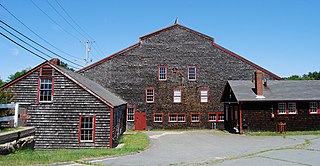
Tremont Nail Factory District is a historic district in Wareham, Massachusetts. It makes up the area occupied by the former Tremont Nail Company.
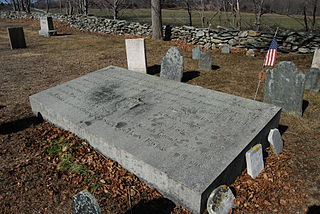
Thomas Baylies was a Quaker ironmaster first in England, then in Massachusetts.
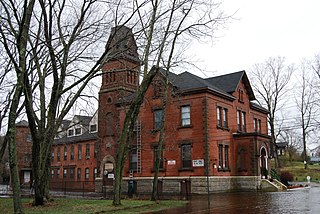
The Albert Field Tack Company is a historic industrial site located at 19 Spring Street in Taunton, Massachusetts, next to the Mill River. Built in 1868 for a company founded in the 1820s to manufacture fasteners, the main office building is an unusually high-style building given its industrial setting. It was added to the National Register of Historic Places in 1984. It has since been converted into apartments.
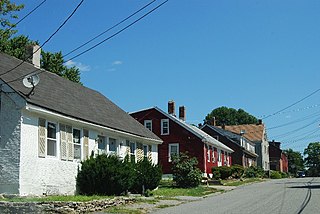
The Hopewell Mills District is a historic district on Bay Street and Albro Avenue in Taunton, Massachusetts. The site is associated with the Hopewell Mills, one of the earliest textile mills in the city, established in 1818.

The John Winthrop Jr. Iron Furnace Site is a historic archaeological site at 61 Crescent Street, Quincy, Massachusetts. The site is called Braintree Furnace in some texts; the West Quincy location at the time of operation was in a part of Braintree, Massachusetts, that later became Quincy. Its importance lies in the fact that it was the first iron blast furnace established in what would become the United States. Furnace Brook, a stream which begins on the eastern slopes of the Blue Hills and meanders for about four miles from southwest to northeast through the middle of Quincy toward Quincy Bay, was named for the works site.

The Tremont Nail Company was a nail manufacturing company located in Wareham, Massachusetts, from 1819 to 2006. The Tremont Nail brand was purchased by Acorn Manufacturing of Mansfield, Massachusetts, where it still produces cut nails and other products for restoration projects. They are the oldest manufacturer of steel cut nails in the United States.

Nahum Stetson was a businessman from southeastern Massachusetts during the 19th century. He is best known for his role in establishing the Bridgewater Iron Company as one of the largest iron works in the United States during the mid-1800s. Stetson was also involved in several other iron companies throughout the southeastern New England region, as well as other notable businesses, including banks and railroads. His grandson, Nahum Stetson (1856-1933) was part of the Steinway & Sons piano company, as part of its sales team and board of directors.

The Taunton Iron Works was located on the banks of the Forge River in what is now Raynham, Massachusetts. It was the first iron works established in Plymouth Colony, and only the third in New England. Much more successful than earlier works at Saugus, and Braintree, it operated for a remarkable period of two hundred and twenty years, from 1656 to 1876.






















